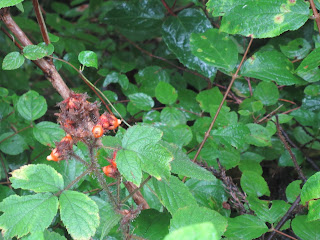I guess you have noticed that for e-DNA primers are very important. Unless there is a suitable primer, no PCR is possible. And we will never be able to have DNA info for all the living creatures on earth, i.e., the catalogue of primers is forever incomplete. In the end, it‘s the realm of the God, Alah, or some deity ... Humans are nonetheless trying to augment the inventory of primers. There is a strong “economic“ incentive. E-DNA is far cheaper option when environmental impact assessment is required before development of some tangible things, like road, port, airport, building, shopping center, etc. Actually Japanese Ministry of Land, Infrastructure, Transport and Tourism will switch to e-DNA completely during project plannings from FY 2028.
 |
| It’s
the chemical to be added for the specimen before the vial undergo the centrifuge treatment. The price tag: USD 340 for 10ml. |
As of December 2023, Japanese aquatic e-DNA analyzers can use workable primers for fish (MiFish: Miya et al. 2015), crustacean (MiDeca: Komai et al. 2019), mammals (MiMammal: Ushio et al. 2016), birds (Mibird: Ushio eta al. 2018), amphibians (Amphi_16S: Sakata eta al.), eels (MiEel: Takeuchi et al. 2019), salamander (Hynobius: Sakai et al. 2019), and insects (MtInsect16S: Takenaka et al. 2021). Come to think of it, the first e-DNA for French bull flog was made public in 2008, and we have already come this far. This is saying something. Making these more comprehensive is an on-going process. For example, MtInsects, the latest workable addition for primers, is the product of long-hour toil in the lab of Shinshu University where they keep on cataloguing the DNA sequence of insects found in Japan. They hope someday their effort will lead to universal primer that can augment at once the sequence of various taxonomic groups from a bottle.
 |
| Someday, the scenery might be more simplified … |
There also are several efforts to expand the method for collecting DNA. The lovely one I found is collecting rain droplets accumulated in a dimple of a leaf. It will gather the information of creatures come and go the leaf, won’t it? Romantic … Some are trying to collect them from the air. Sure, hay fever is coming from the airborne pollens constructed by their DNA. In Kobe, researchers are collecting soil for DNA in order to assess the effect of anti-deer measures in their forest. In short, many people in this archipelago try to utilize e-DNA analysis for cataloguing what’s dwelling in our land, besides the homo sapience.
 |
| Soon here becomes a safe for DNA data. |
Moreover, currently the big project is taking place to make a database that is comprised of DNA data collected from all over Japan. Prof. Michio Kondoh of Tohoku University organized a consortium that establishes and manages a big DNA data gathered from the nation’s landscapes. It’s called ANEMONE. ANEMONE is already operational and anybody in this universe with internet access can search for DNA that is catalogued in Japan. Kanagawa Environmental Research Center is a proud founding member of the consortium (a bragging smile of Mr. Hasebe). This DB is a part of the Japanese effort in 30-by-30 roadmap corresponding to Kunming-Montreal Global Biodiversity Framework adopted at COP15 in 2022. As a national strategy, Japanese government pledges to aim for 30% of domain to be biodiversity sensitive, and there to achieve nature positive way of life. Prof. Kondoh and his gangs make ANEMONE open and to be used for anybody who engages in self-management of our nature that should yield sustainable co-existence of human community and wildlife. (… er, the DB has data from Japan, so I don’t think it is perfectly applicable to, say, Korean Peninsula …) In this regard, what we volunteers enjoy for monitoring water source forest of Yadoriki is in the context of SDGs (a bragging smile of Naomi 😊)!
 |
| The entrance page for ANEMONE DB |
… yeah, that all sounds grandiose, but actually, it’s not that so serious. In the end, we forest instructors stroll Yadoriki Water Source Forest alone ourselves, or with visitors, and enjoy lots of findings of natural wonder, from trees, flowers, butterflies, fishes, gadflies, … Sometimes we are greeted by serows or flying squirrels, entertained by beautiful songs of blue-and-white flycathcer, while relaxed watching a flow of clouds in a clear blue sky. We simply record what we have met in the forest, and the result is feeding into the database. Our playground happens to be a part of global effort. Don‘t you think how lucky we are?
1-3-39 Shinomiya, Hiratsuka City, 254-0014
〒254-0014平塚市四之宮1-3-39
Phone: 0463-24-3311
FAX: 0463-24-3300
k-center@k-erc.pref.kanagawa.jp
























